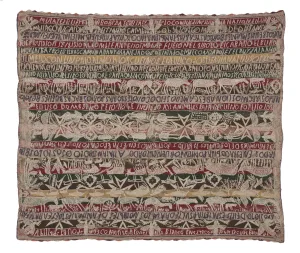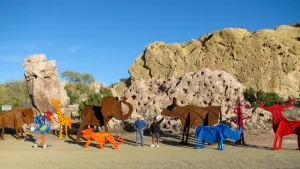This New Mexico city features a variety of unusual galleries and museums that will fill you with childlike wonder and awe.
By Bianca Dumas
November-December 2025
Art is for everyone, but not everyone knows it. Some of us might feel intimidated walking into a gallery where the works on the wall are valued at $10,000 each — or more. We may think we need to have a particular vocabulary when we go into a museum and encounter phrases like “abstract landscape” or “pop surrealism,” fearing that the lack of an art-school degree means these places are not for us.
But it isn’t so. Everyone is attracted, awed, and inspired by something, if they only know where to look. My dad, a rural guy who likes to write cowboy poetry and hunt waterfowl with his dogs, enjoys gazing at realistic Western art and items made from wood or leather. My mom, a seamstress, is impressed by textiles. And all kids seem to love kinetic sculpture, designed to bend, wave, and even twirl in the breeze.

The Museum of International Folk Art houses over 135,000 objects from over 100 countries, including works in the “Multiple Visions: A Commond Bond” exhibit.
One potentially daunting place is Santa Fe, New Mexico, where the art scene can be overwhelming. The city has 250 galleries and more than a dozen museums, and many folks know about the expensive works for sale along Canyon Road.
Next time you visit Santa Fe, step away from the well-known galleries and check out some of the surprising, quirky art elsewhere. The museum halls may be hushed, but don’t let that bother you. Take the opportunity to absorb, uninterrupted, the works on display. And bring the kids or grandkids along. You might need to hold a little hand and remind them to “look but don’t touch,” but you’ll be gratified by their wide eyes and impressed whispers. Back in the RV, they might even be inspired to create their own art, which is the whole point.
Typical of galleries and museums, many exhibitions are temporary, with new displays forthcoming. So, whenever you visit, enjoy the experience.

The Museum of International Folk Art displays embroidered textiles by Policarpio Valencia.
On Museum Hill, one of the many options is the Museum of International Folk Art (moifa.org). If you aren’t versed in fine art and its terminology, you might want to start with this type of art — stuff made by regular people, typically with no formal art education, who express themselves with the materials they have on hand. Folk art tells the personal story of an individual or their culture, and creating the art is a hobby or a passion for the artist, not a career. This museum houses one of the largest collections of folk art in the world.
Although it may not have a particularly intriguing name, “Multiple Visions: A Common Bond” is a great place to start. This permanent exhibit has welcomed over a million first-time and repeat visitors. The works by a single artist, Alexander Girard, are so extensive — displaying 10,000 pieces from a collection of 100,000 — that an entire wing had to be built to house them. It features tiny sculpted figures and scenes from daily life, made of clay, wood, paper, cloth, and plastic, and portraying people and animals from cultures around the world.
Be sure to see the intricate sand drawings in the “Sandroing” exhibit, which features artistry from the Pacific Islands. “Appearances Deceive” showcases the work of artist Policarpio Valencia, whose embroidered textiles explore serious themes of morality and mortality with wit and whimsy. These exhibits run through April 2026 and July 2026, respectively.
The New Mexico Museum of Art (nmartmuseum.org) includes two buildings, both accessible with one ticket: the historic Plaza Building, located on the Santa Fe Plaza; and Vladem Contemporary, situated at the bottom of Museum Hill in the Railyard District.

The ”Window Box” installation outside New Mexico Museum of Art’s Vladem Contemporary.
A current exhibition at the Plaza Building, which runs through February 2026, offers a retrospective of Gustave Baumann’s works. The beloved artist and cultural figure in Santa Fe was known for his woodblock prints, and he also produced paintings, drawings, sculptures, marionettes, and furniture. “The Artist’s Environment” exhibit explores Baumann’s artistic creations and his contributions to New Mexico’s cultural and artistic identity. “Green Dragon” is a whimsical compilation of suede, leather, painted wood, red silk, cordage, metal loops, and string.
The “Fritz Family Digital Window” is an outdoor display located on the west-facing side of Vladem Contemporary, at Guadalupe Street and Montezuma Avenue. It broadcasts artists’ videos, animations, and short films in the evenings. Visitors can stream the audio on their smartphones, similar to using a drive-in movie speaker. It runs through December 31, 2025.

Meow Wolf Santa Fe offers immersive art experiences and interactive exhibits.
Since you’re already at the Railyard, take Cerillos Road west to the ultra-quirky Meow Wolf Santa Fe’s House of Eternal Return (meowwolf.com/visit/santa-fe), an immersive, maximalist art experience cofounded by a local artists’ collective. It’s like a black-light, neon version of what Alice might have seen in Wonderland. This permanent exhibition is continually enhanced and updated, with spaces that put you inside optical illusions or imaginary scenarios. In one room, you might be a cartoon character in a space where everything seems two-dimensional. In another, you’re a fish in a glowing aquarium. In Fancy Town, you could catch a concert or check out the central lighthouse.
Meow Wolf gives viewers an opportunity to explore and appreciate the unusual by presenting things in different contexts than we might be used to.

Fredrick Prescott’s fanciful animals at the Prescott Gallery and Sculpture Garden are fashioned of powder-coated steel.
And just around the corner, don’t miss the amazing Prescott Gallery and Sculpture Garden, also known as Prescott Studio (prescottstudio.com). Visiting here is like going on safari in a botanical setting, where all the animals are created from powder-coated steel and engineered for near-perpetual motion. You might see a red Spanish bull with a frown, wagging its head disapprovingly, while a blue hippo — obviously having a better day — nods and smiles. Sure, the costs of the sculptures are in the tens of thousands of dollars, but you don’t have to buy one to enjoy the garden — and the campground you’re staying in wouldn’t like that, anyway.
Self-taught artist Fredrick Prescott grew up in a machine shop and has been working with steel and paint since he was a kid. Some of his sculptures are based on the principle of pendulum movement and are wind-driven, while others are motorized, like the 30-foot giraffe that serves as the garden’s entry gate. Prescott’s work is so well-known that he’s made sculptures for Looney Tunes and Disney. There’s also a 5,000-square-foot gallery space, and both can be seen at no charge.
Next time you visit a town known for its art, don’t be intimidated. Walk right into the galleries and museums that catch your eye and take a look. You don’t need to know the right vocabulary, and you might find a kind of art that makes your heart soar or your head nod, just like that shiny blue hippo.

